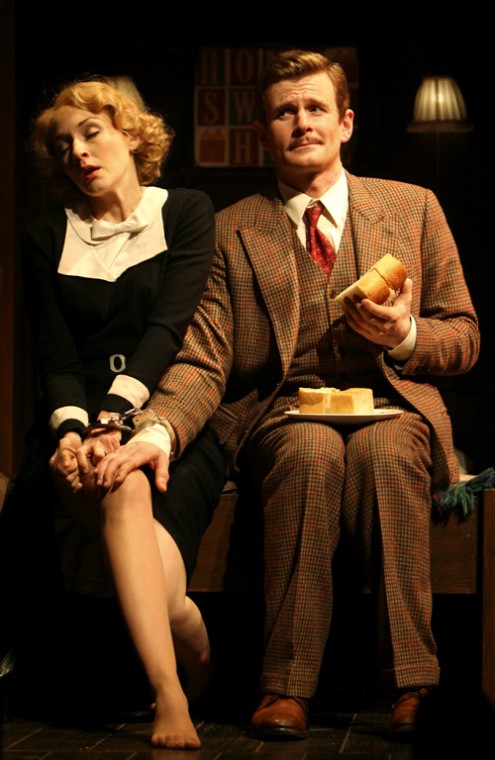Actors work double time to keep up with stage version of Hitchcock’s ’39 Steps’
This undated photo provided by Boneau/Bryan-Brown shows Jennifer Ferrin, left, and Charles Edwards in a scene from “The 39 Steps.” Joan Marcus, The Associated Press
February 6, 2008
NEW YORK – In “The 39 Steps,” a clever spoof of Alfred Hitchcock’s 1935 movie thriller, leading man Charles Edwards climbs ladders, dashes across the spare stage countless times and practically hurls himself off balconies.
Jennifer Ferrin plays all three women characters including the tale’s blond heroine as well as the murder victim.
Then there are Arnie Burton and Cliff Saunders as Man 1 and Man 2, on hand to portray everyone else, which means scores of characters, both male and female. Oh, and they have to shuffle sets around the stage, too.
This lack of cast is purposeful – as is the silliness that ensues with the less-is-more mentality of the Roundabout Theatre Company production now playing on Broadway.
When director Maria Aitken started work on the play, she pictured a tattered little theater company somewhere in the English countryside, with a snobbish leading man who agrees to play one role (and can’t be bothered moving sets) and a leading lady who is coerced into playing three characters.
Get The Daily Illini in your inbox!
“And there are two old vaudevillians in the company … who have done everything together, absolutely hand in glove, and, in my mind anyway, they’re allowed to be in the play only on the condition they play absolutely everything else,” Aitken said.
Except for the diva mentality and ratty company, Aitken essentially got what she wanted in the production, where the four actors work as a team to bring the film to the stage.
“It’s been highly collaborative – the movement coach, the designer, the writers. I cannot stress enough how much of a collaborative effort it’s been,” she said.
The story is a spy caper complete with stereotypical props and costumes – monocles, missing appendages. It is centered on debonaire Richard Hannay and his flight from various villains who are out to get him after a mysterious woman is murdered in his West End flat.
The script was written by Patrick Barlow, who expanded on the original concept by Simon Corble and Nobby Dimon. They were inspired by the John Buchan novel, which was the basis for the 1935 movie starring Robert Donat. Aitken was brought on board to direct the play, which first appeared in London’s equivalent of off-Broadway and later in the West End.
“It’s a demented chain of events, isn’t it?” Aitken said. “Our play is a homage to theater. But we’re doing it in a self-referential, looney way. Not sarcastic, really, but trying to tell the story.”
The conceit is familiar to Brits, but not necessarily to an American audience. And so cast and crew were worried that no one would get the wink-and-nod jokes and surreal staging – among his characters, Saunders plays a waterfall and a cleft.
“We didn’t know if there would be silence in the theater when we performed,” Aitken said.
But after a successful tryout in Boston, the production opened Jan. 16 at the Roundabout’s American Airlines Theatre to gleaming reviews. The show is no stranger to praise, winning an Oliver Award for best new comedy last year in London.
It’s not necessary to have seen the Hitchcock film to enjoy the stage version, but it does add to the play’s enjoyment to see how some of the movie’s more sweeping scenes are staged. Even Aitken wasn’t much of a Hitchcock fan before, but she made sure to throw in several funny references to other famous Hitchcock scenes.
The cast is particularly proud of a shadow puppet scene that portrays Hannay’s escape to the Scottish Highlands.
“Shadow play is one of the oldest forms of entertainment. They used to do it on cave walls,” Saunders said. “I love that. This show is like how children play – you take a trunk and you make it something, and you go out and do as many characters as you can just to make sure you tell the story.”
Saunders and Burton didn’t know each other before the play, but now function like a well-oiled machine, even working off each other in a backstage conversation after a performance. They are animated and physical when talking about the play, belying their impressive vaudevillian skills.
They play a parade of characters, from cops to laughing lingerie salesmen to a bit of drag (both men get to dress up as women). The changes are fast and at one point, they even play two characters at once.
They won’t say exactly how many roles they have. “I don’t even want to know,” Saunders said with a smile.
“The trick for this show is when you’re in your character, be that character 100 percent and don’t think about what’s coming next,” he said. “So you have to be that character and then snap into another one. You train your body to switch over to a completely different kind of person in a heartbeat.”
The actors are exhausted by the end of each night, and say it’s difficult to remember all the quick changes. Somehow, though, they manage to get on stage and make their cues.
“We have amazing people backstage – dressers – that we just run off into the dark and they rip our clothes off and throw clothes back on us,” Burton said.
Aitken said she’s able to coax great performances from her cast, in part because she was an actress for years, performing on stage, television and in film before she quit to direct more than 20 plays.







